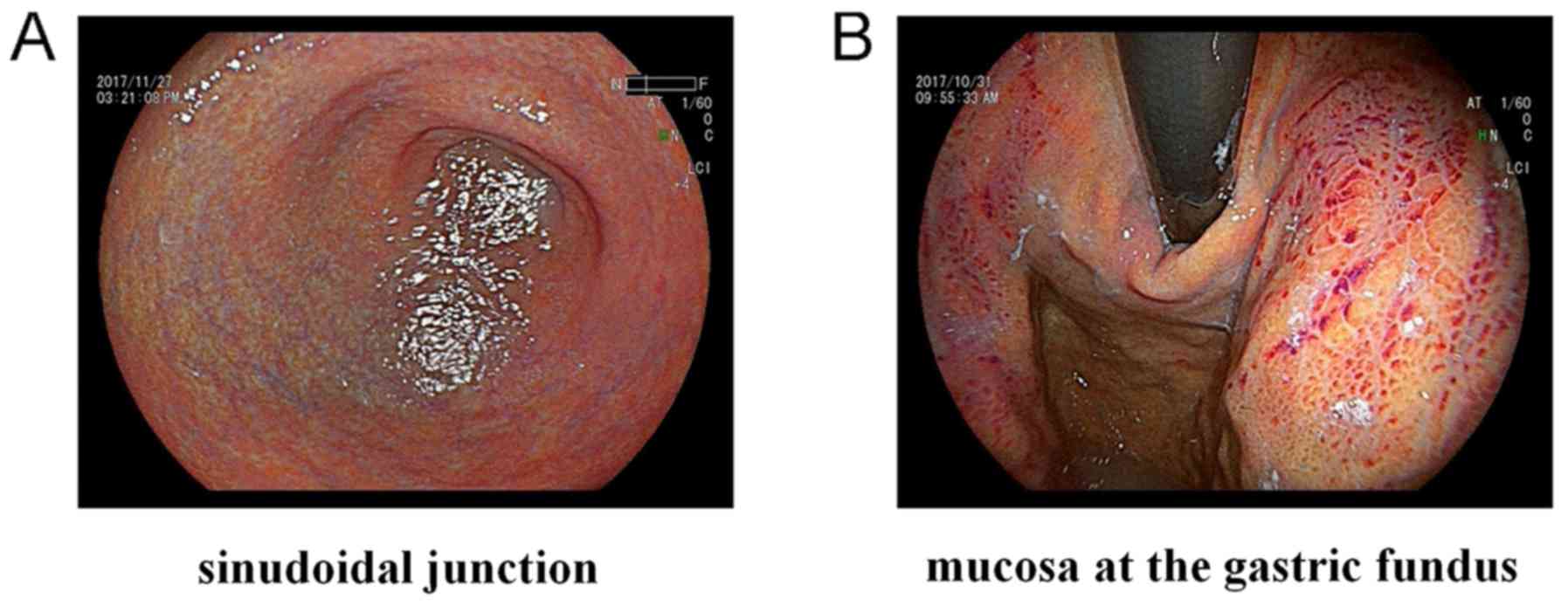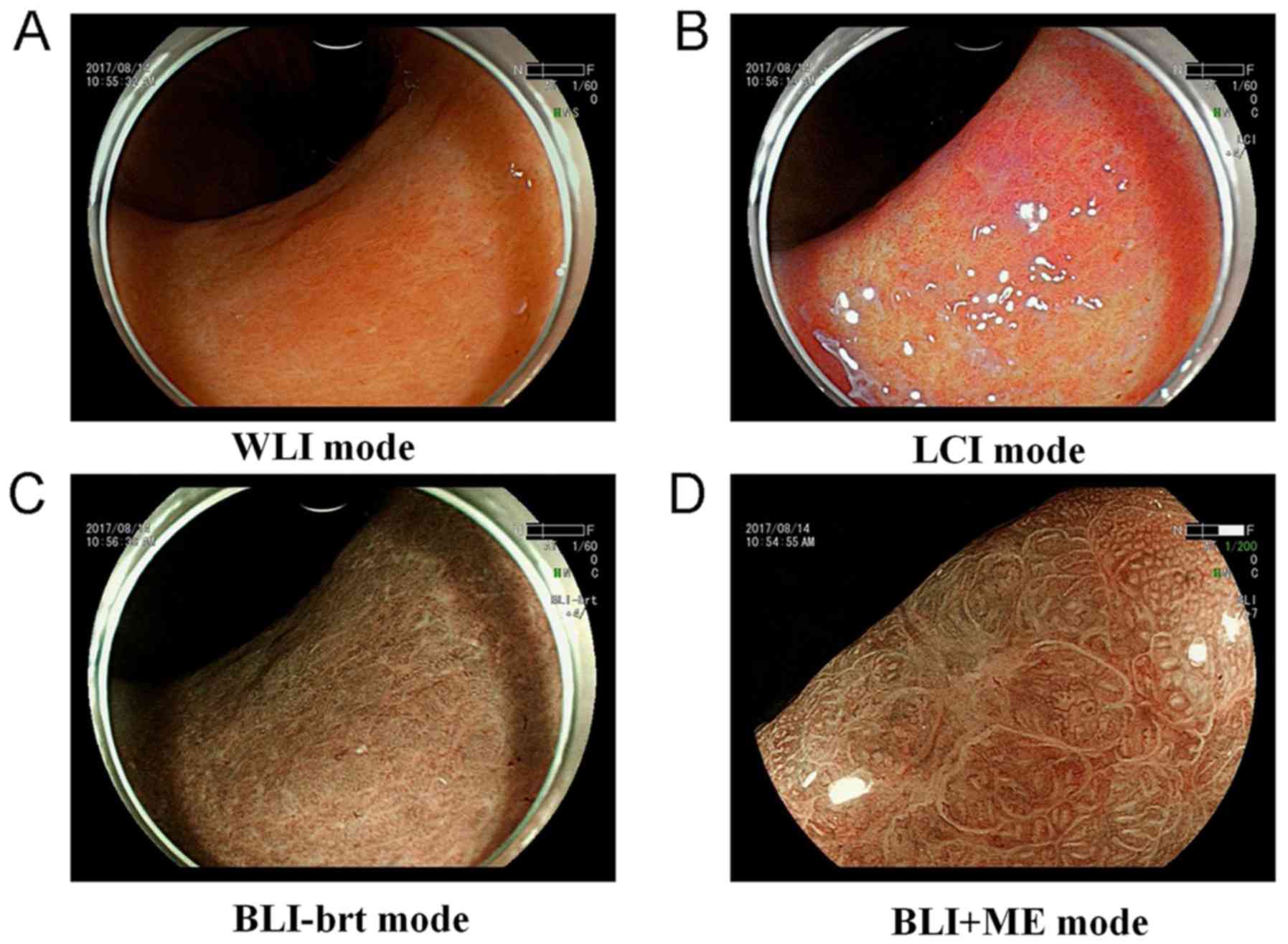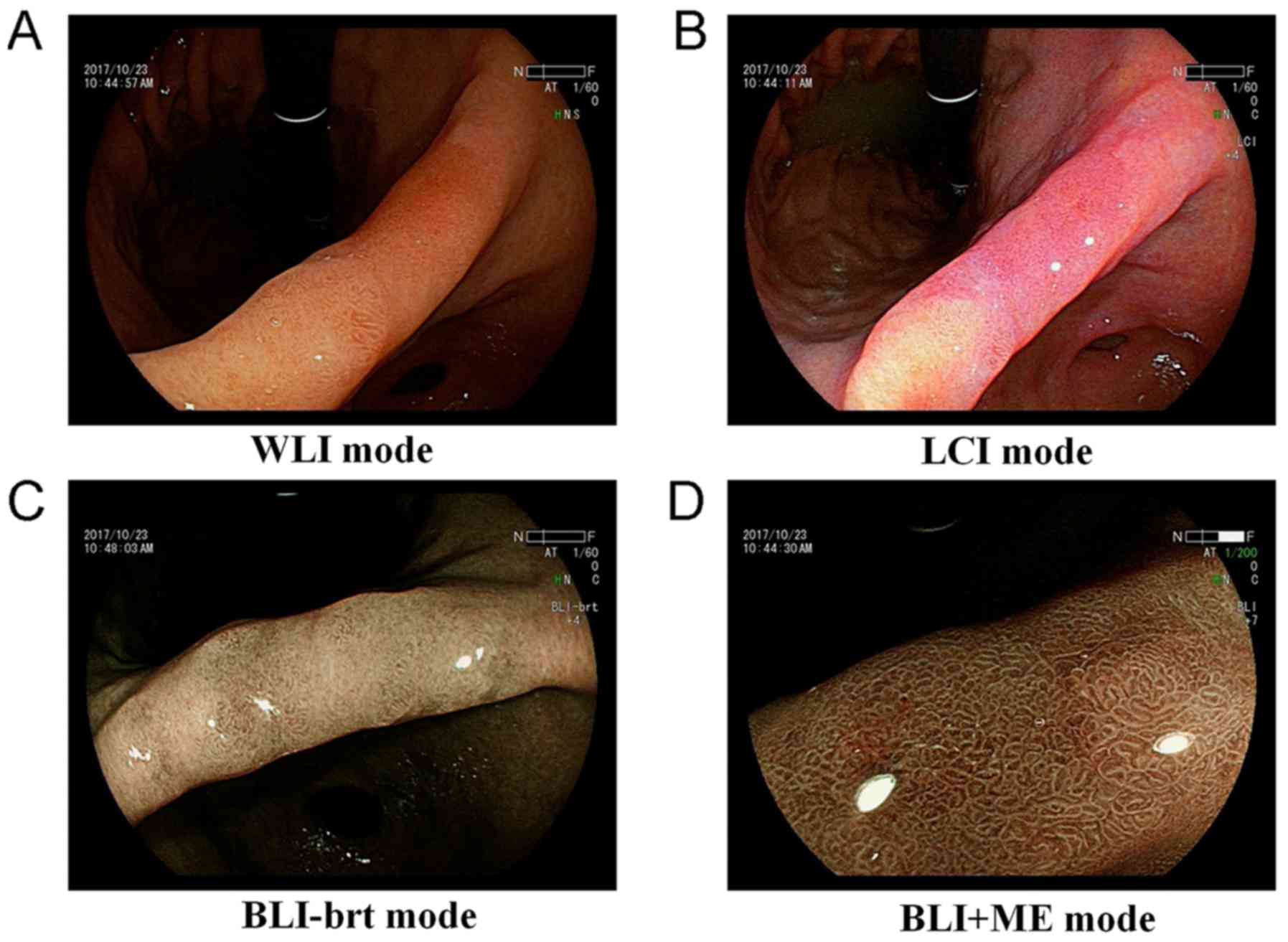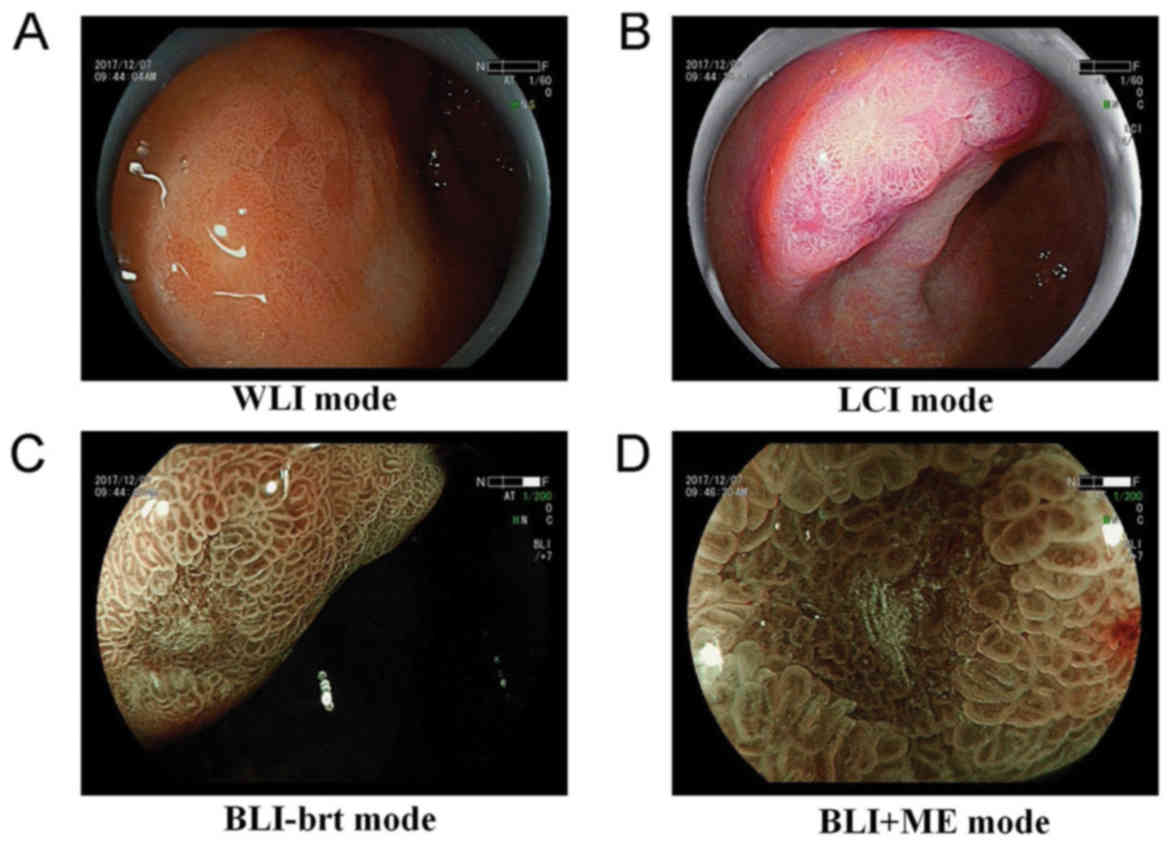|
1
|
Çolakoğlu EÇ, Börkü K, Haydardedeoğlu AE,
Alihosseini H, Şenel OO, Yumuşak N, Özen D, Baş B and Uğurlu L:
Correlation between endoscopic and histopathological findings in
dogs with chronic gastritis. J Vet Res. 61:351–355. 2017.
View Article : Google Scholar : PubMed/NCBI
|
|
2
|
Liu Y, Gong H, Liu J and Zhang H: Acupoint
selection pattern of chronic atrophic gastritis based on data
mining methods of latent structure model and frequency item set.
Zhongguo Zhen Jiu (Chinese). 38:667–671. 2018.
|
|
3
|
Cherdantseva LA, Potapova OV, Sharkova TV,
Belyaeva YY and Shkurupiy VA: Association of Helicobacter
pylori and iNOS production by macrophages and lymphocytes in
the gastric mucosa in chronic gastritis. J Immunol Res.
2014:7625142014. View Article : Google Scholar : PubMed/NCBI
|
|
4
|
Sonnenberg A and Genta RM: Prevalence of
benign gastric polyps in a large pathology database. Dig Liver Dis.
47:164–169. 2015. View Article : Google Scholar : PubMed/NCBI
|
|
5
|
Jiang JX, Liu Q, Zhao B, Zhang HH, Sang
HM, Djaleel SM, Zhang GX and Xu SF: Risk factors for intestinal
metaplasia in a southeastern Chinese population: An analysis of
28,745 cases. J Cancer Res Clin Oncol. 143:409–418. 2017.
View Article : Google Scholar : PubMed/NCBI
|
|
6
|
Tsimmerman YS and Zakharova YA: Kyoto
consensus-The new etiological classification of chronic gastritis
and its discussion. Klin Med (Mosk) (Russian). 95:181–188.
2017.
|
|
7
|
Tsimmerman YS and Zakharova YA: Topical
problems of chronic gastritis. Klin Med (Mosk) (Russian). 95:8–14.
2017.
|
|
8
|
Yoon H and Kim N: Diagnosis and management
of high risk group for gastric cancer. Gut Liver. 9:5–17. 2015.
View Article : Google Scholar : PubMed/NCBI
|
|
9
|
Pasechnikov V, Chukov S, Fedorov E,
Kikuste 1 and Leja M: Gastric cancer: Prevention, screening and
early diagnosis. World J Gastroenterol. 20:13842–13862. 2014.
View Article : Google Scholar : PubMed/NCBI
|
|
10
|
Rudnicka K, Backert S and Chmiela M:
Genetic polymorphisms in inflammatory and other regulators in
gastric cancer: Risks and clinical consequences. Curr Top Microbiol
Immunol. 421:53–76. 2019.PubMed/NCBI
|
|
11
|
Strong VE, Wu AW, Selby LV, Gonen M, Hsu
M, Song KY, Park CH, Coit DG, Ji JF and Brennan MF: Differences in
gastric cancer survival between the U.S and China. J Surg Oncol.
112:31–37. 2015. View Article : Google Scholar : PubMed/NCBI
|
|
12
|
Karimi P, Islami F, Anandasabapathy S,
Freedman ND and Kamangar F: Gastric cancer: Descriptive
epidemiology, risk factors, screening, and prevention. Cancer
Epidemiol Biomarkers Prev. 23:700–713. 2014. View Article : Google Scholar : PubMed/NCBI
|
|
13
|
Yoshida N, Dohi O, Inoue K, Yasuda R,
Murakami T, Hirose R, Inoue K, Naito Y, Inada Y, Ogiso K, et al:
Blue laser imaging, blue light imaging, and linked color imaging
for the detection and characterization of colorectal tumors. Gut
Liver. 13:140–148. 2019. View
Article : Google Scholar : PubMed/NCBI
|
|
14
|
Nakashima H, Kawahira H, Kawachi H and
Sakaki N: Artificial intelligence diagnosis of Helicobacter
pylori infection using blue laser imaging-bright and linked
color imaging: A single-center prospective study. Ann
Gastroenterol. 31:462–468. 2018.PubMed/NCBI
|
|
15
|
Togashi K, Nemoto D, Utano K, Isohata N,
Kumamoto K, Endo S and Lefor AK: Blue laser imaging endoscopy
system for the early detection and characterization of colorectal
lesions: A guide for the endoscopist. Therap Adv Gastroenterol.
9:50–56. 2016. View Article : Google Scholar : PubMed/NCBI
|
|
16
|
Horiguchi N, Tahara T, Kawamura T, Okubo
M, Tahara S, Nagasaka M, Nakagawa Y, Shibata T and Ohmiya N: A
comparative study of white light endoscopy, chromoendoscopy and
magnifying endoscopy with narrow band imaging in the diagnosis of
early gastric cancer after Helicobacter pylori eradication.
J Gastrointestin Liver Dis. 26:357–362. 2017.PubMed/NCBI
|
|
17
|
Osawa H and Yamamoto H: Present and future
status of flexible spectral imaging color enhancement and blue
laser imaging technology. Dig Endosc Suppl. 1:105–115. 2014.
View Article : Google Scholar
|
|
18
|
Zhou F, Wu L, Huang M, Jin Q, Qin Y and
Chen J: The accuracy of magnifying narrow band imaging (ME-NBI) in
distinguishing between cancerous and noncancerous gastric lesions:
A meta-analysis. Medicine (Baltimore). 97:e97802018. View Article : Google Scholar : PubMed/NCBI
|
|
19
|
Nagahama T, Yao K, Uedo N, Doyama H, Ueo
T, Uchita K, Ishikawa H, Kanesaka T, Takeda Y, Wada K, et al:
Delineation of the extent of early gastric cancer by magnifying
narrow-band imaging and chromoendoscopy: A multicenter randomized
controlled trial. Endoscopy. 50:566–576. 2018. View Article : Google Scholar : PubMed/NCBI
|
|
20
|
Diao W, Huang X, Shen L and Zeng Z:
Diagnostic ability of blue laser imaging combined with magnifying
endoscopy for early esophageal cancer. Dig Liver Dis. 50:1035–1040.
2018. View Article : Google Scholar : PubMed/NCBI
|
|
21
|
Cao HL, Dong WX, Xu MQ, Zhang YJ, Wang SN,
Piao MY, Cao XC and Wang BM: Clinical features of upper
gastrointestinal serrated lesions: An endoscopy database analysis
of 98746 patients. World J Gastroenterol. 22:10038–10044. 2016.
View Article : Google Scholar : PubMed/NCBI
|
|
22
|
Moehler M, Voigt J, Kastor M, Heil M,
Sengespeick C, Biesterfeld S, Dippold W, Kanzler S and Galle PR:
Endoscopic ultrasonography-guided fine-needle aspiration (EUS-FNA)
as primary diagnostic tool for unclear lesions in the upper
gastrointestinal tract. Dtsch Med Wochenschr (German). 136:303–308.
2011. View Article : Google Scholar
|
|
23
|
Society of Digestive Diseases, Chinese
Medical Association, Fang Jingyuan, Liu Wenzhong, et al: China
Consensus on Chronic Gastritis (Shanghai, 2012). Chinese Journal of
Digestion. 33:5–16. 2013.
|
|
24
|
Tian G, Wu C, Li J, Liang B, Zhang F, Fan
X, Li Z, Wang Y, Li Z, Liu D, et al: Network pharmacology based
investigation into the effect and mechanism of Modified Sijunzi
Decoction against the subtypes of chronic atrophic gastritis.
Pharmacol Res. 144:158–166. 2019. View Article : Google Scholar : PubMed/NCBI
|
|
25
|
Negovan A, Iancu M, Moldovan V, Sàrkàny K,
Bataga S, Mocan S, Țilea I and Banescu C: The contribution of
clinical and pathological predisposing factors to severe
gastro-duodenal lesions in patients with long-term low-dose aspirin
and proton pump inhibitor therapy. Eur J Intern Med. 44:62–66.
2017. View Article : Google Scholar : PubMed/NCBI
|
|
26
|
Fukuda H, Miura Y, Hayashi Y, Takezawa T,
Ino Y, Okada M, Osawa H, Lefor AK and Yamamoto H: Linked color
imaging technology facilitates early detection of flat gastric
cancers. Clin J Gastroenterol. 8:385–389. 2015. View Article : Google Scholar : PubMed/NCBI
|
|
27
|
Guo XY, Dong L, Qin B, Jiang J and Shi AM:
Decreased expression of gastrokine 1 in gastric mucosa of gastric
cancer patients. World J Gastroenterol. 20:16702–16706. 2014.
View Article : Google Scholar : PubMed/NCBI
|
|
28
|
Watari J, Chen N, Amenta PS, Fukui H,
Oshima T, Tomita T, Miwa H, Lim KJ and Das KM: Helicobacter
pylori associated chronic gastritis, clinical syndromes,
precancerous lesions, and pathogenesis of gastric cancer
development. World J Gastroenterol. 20:5461–5473. 2014. View Article : Google Scholar : PubMed/NCBI
|
|
29
|
Sipponen P and Maaroos HI: Chronic
gastritis. Scand J Gastroenterol. 50:657–667. 2015. View Article : Google Scholar : PubMed/NCBI
|
|
30
|
Kosztyła-Hojna B, Berger G and Zdrojkowski
M: Phonosurgical methods of treatment in unilateral vocal folds
paralysis. Pol Merkur Lekarski (Polish). 42:173–177. 2017.
|


















